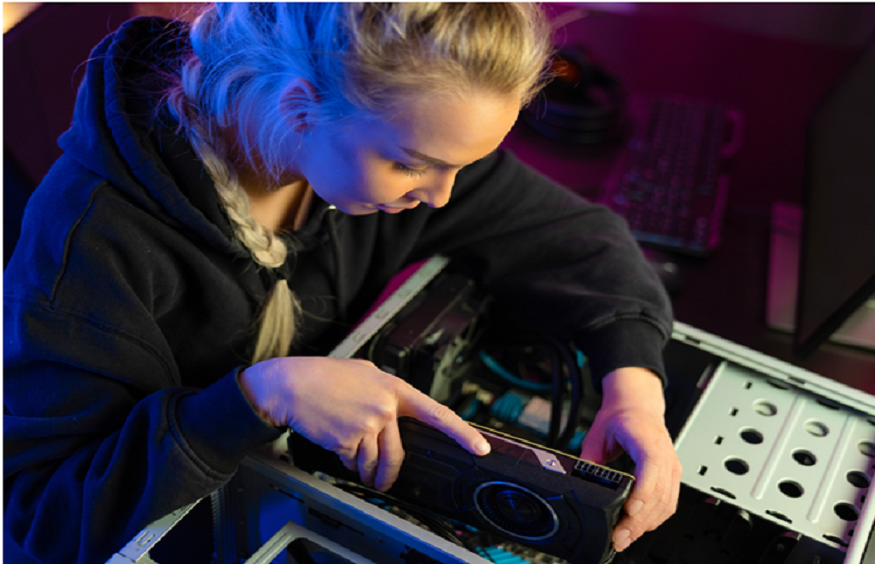So, you’re diving into the wonderful (and sometimes tricky) world of PC building and asking yourself: Can I install two graphics cards in my rig? The short answer is yes — you can. But before you start dreaming of double (or even triple) GPU power, let’s hit the pause button and dive into the nitty-gritty. While technically possible, it’s not quite the game-changer it once was. Grab your tools — and maybe a snack — because we’re going to build out the details and explore whether this route is right for you.
The Current State of Multi-GPU Setups
Remember the glory days of NVIDIA’s SLI and AMD’s CrossFire? These technologies allowed gamers and PC enthusiasts to link multiple graphics cards together to squeeze out extra performance. It was like strapping a rocket to your PC build. However, fast forward to today, and these technologies are pretty much hanging out in retirement. For most PC builders, single GPU setups have become the standard, and the days of stacking GPUs like they’re pancakes are fading into the background.
This shift happened for a few reasons. The most important being that modern GPUs are monsters in their own right. Graphics cards today can handle pretty much everything you throw at them — from high-end gaming to professional workloads — without breaking a sweat. Let’s face it — it’s like trying to upgrade a Ferrari. It’s already fast enough, right?
Why Most Users Stick with One GPU
So, why did the multi-GPU dream fade for most users? It boils down to the fact that today’s top-tier graphics cards are already extremely powerful. You don’t need two GPUs when one beast can easily handle your tasks.
Modern GPUs are designed with:
- Incredible performance: They can render high-res textures, tackle ray tracing, and handle 4K gaming like a champ.
- Better software optimization: Developers focus on optimizing for single GPU setups, meaning you won’t get much (if any) extra performance from adding a second card.
- Power efficiency: Running one GPU uses significantly less power than two. Less power means less heat, and less heat means less strain on your cooling system and PSU.
For most gamers, a single high-end GPU gets the job done. That’s why multi-GPU setups have become a niche within the broader PC enthusiast community.
Source: Kjetil Kolbjornsrud/Shutterstock.com
When Multiple GPUs Make Sense
Now, before you ditch the idea of multi-GPU entirely, there are still some scenarios where doubling up on graphics cards can be beneficial — if not essential.
- Professional Workloads: If you’re knee-deep in 3D rendering, machine learning, or scientific computing, you might need more than one GPU. These tasks thrive on raw GPU power, and some specialized applications can efficiently harness multiple GPUs at once.
- Multi-Monitor Setups: If you’ve got a six-monitor command center going on (because why not?), extra GPUs might be necessary to drive that many pixels. While not as common anymore, some users running ultra-high resolutions may still find this useful.
So, while multi-GPU setups aren’t as popular in gaming and general use anymore, they’re not entirely out of the picture, especially for professionals and developers.
The Challenges of Multiple Graphics Cards
Before you go digging for your second GPU, know that multi-GPU setups come with their own set of challenges. It’s not just about popping in another card. There are plenty of roadblocks to consider.
- Compatibility Issues: Not all software supports multi-GPU setups. Games, in particular, are usually optimized for single GPU systems, and adding a second card can result in minimal performance gains (if any at all).
- Increased Complexity: You’re not just doubling up on GPUs — you’re also doubling the potential for headaches. Troubleshooting multi-GPU setups can be tricky, especially if drivers or software don’t play nice.
- Power Consumption and Heat: More GPUs equal more power consumption, meaning you’ll need a motherboard and PSU to handle the load. It also means more heat, which can quickly become an issue if your cooling solution isn’t up to the task.
- Higher Costs: Graphics cards aren’t cheap, nor are the additional components you’ll need to support a multi-GPU system. For most users, the cost of going multi-GPU outweighs the benefits.
Hardware You’ll Need for a Multi-GPU Setup
If you’re still sold on the idea of running multiple GPUs, there are a few hardware considerations you’ll need to keep in mind. Not every motherboard or PSU can handle this kind of setup, so here’s what you’ll need:
- Motherboard with Multiple PCIe Slots: Not all motherboards come equipped with the extra PCIe slots required for multiple graphics cards. Make sure your board has enough slots and is designed to handle multi-GPU configurations.
- Power Supply Unit: Running multiple GPUs will require a beefy power supply unit (PSU). You’ll want a power supply with enough wattage to support your cards, plus the rest of your components. More GPUs = more power.
- Cooling: More GPUs means more heat, so you’ll need to ensure that your case has plenty of airflow. Consider adding extra fans, or even a liquid cooling solution, to keep temperatures in check.
- A Spacious Case: Not only will you need space for the cards themselves, but also for efficient cable management and airflow. Make sure your case can comfortably house everything.

Source: ESOlex/Shutterstock.com
Performance Expectations with Multiple GPUs
Before you get too excited about doubling your performance, let’s clear up a common misconception: two GPUs don’t mean double the performance. In most gaming and consumer use cases, the performance gains from multiple GPUs are marginal at best.
Sure, in certain professional applications (think rendering or AI tasks), multiple GPUs can offer a nice boost in performance, but when it comes to gaming, the benefits are often far less than expected. Many games simply aren’t optimized for multi-GPU setups, meaning that the second card may be left sitting idle for most of the time.
Alternatives to Multi-GPU Setups
For most users, the better option is to invest in a single high-end GPU rather than multiple lower-end cards. Modern GPUs are incredibly powerful, and a single card is usually all you need to handle high-end gaming, 4K rendering, or professional workloads.
- Single high-end GPUs: GPUs like the NVIDIA RTX 4090 or AMD RX 7900 XT pack more than enough power for even the most demanding tasks.
- Improved Compatibility: A single GPU will be fully optimized for most games and applications, meaning fewer headaches when it comes to software compatibility.
- Simplicity: Fewer components mean fewer things that can go wrong. With a single GPU, your system will be easier to maintain, troubleshoot, and upgrade down the line.
The Future of Multi-GPU Technology
Multi-GPU setups may not be as common as they once were for gaming, but that doesn’t mean the technology is dead. In professional and enterprise environments, multi-GPU setups are still going strong. As AI, deep learning, and complex rendering tasks become more advanced, multi-GPU configurations will continue to play a crucial role in those industries.
For the average consumer, however, single-GPU setups will likely remain the go-to solution for years to come. Unless new breakthroughs in multi-GPU technology arise, we’re sticking with one card to rule them all.
Two GPUs or Not Two GPUs: That’s the Real Question
So, can you have multiple graphics cards in one PC? Absolutely. But should you? For most users, the answer is a polite “probably not.” Unless you have a specialized workload that can take advantage of multiple GPUs, your best bet is to stick with a single powerful card that’ll give you the performance you need without the added complexity. After all, sometimes, less is more!

